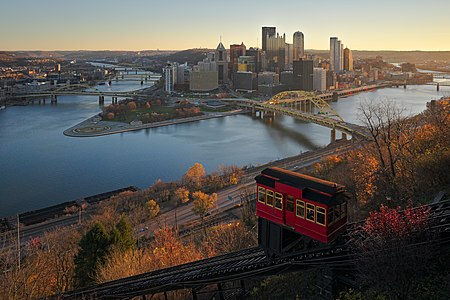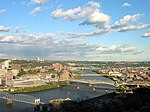Duquesne Incline

The Duquesne Incline () is a funicular located near Pittsburgh's South Side neighborhood and scaling Mt. Washington in Pittsburgh, Pennsylvania, United States. Designed by Hungarian-American engineer Samuel Diescher, the incline was completed in 1877. The lower station is in the Second Empire style. Together with the incline, which rises 400 feet (122 m) in height, at a 30-degree angle, it was listed on the National Register of Historic Places in 1975. The incline is unusual for having a track gauge standard used only in Finland, Russia, and Mongolia. Together with the Monongahela Incline, it is one of two passenger inclines still in operation on Pittsburgh's South Side. By 1977, the two had become tourist attractions and together served more than one million commuters and tourists annually. That year both inclines were designated as Historic Mechanical Engineering Landmarks by the American Society of Mechanical Engineers (ASME).
Excerpt from the Wikipedia article Duquesne Incline (License: CC BY-SA 3.0, Authors, Images).Duquesne Incline
West Carson Street, Pittsburgh
Geographical coordinates (GPS) Address Nearby Places Show on map
Geographical coordinates (GPS)
| Latitude | Longitude |
|---|---|
| N 40.439166666667 ° | E -80.018055555556 ° |
Address
Duquesne Lower Station
West Carson Street
15211 Pittsburgh
Pennsylvania, United States
Open on Google Maps







